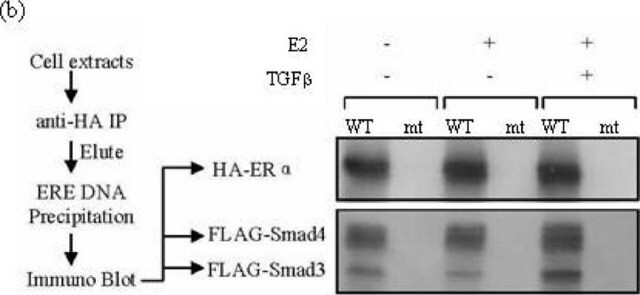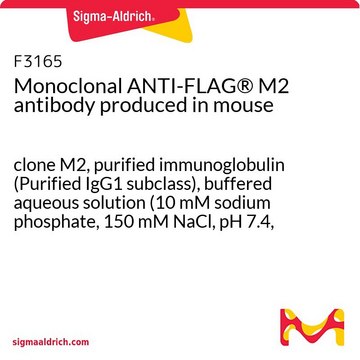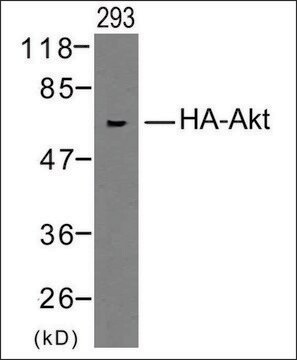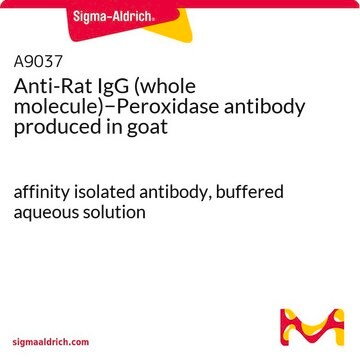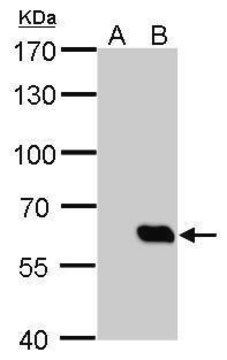추천 제품
생물학적 소스
rat
Quality Level
결합
unconjugated
항체 형태
purified immunoglobulin
항체 생산 유형
primary antibodies
클론
3F10, monoclonal
양식
lyophilized
포장
pkg of 50 μg (11867423001)
pkg of 500 μg (11867431001)
제조업체/상표
Roche
동형
IgG1
에피토프 서열
YPYDVPDYA
저장 온도
2-8°C
관련 카테고리
일반 설명
Anti-HA High Affinity is a monoclonal antibody to the HA-peptide (clone 3F10). Anti-HA High Affinity recognizes the HA peptide sequence (YPYDVPDYA), derived from the influenza hemagglutinin protein. The antibody recognizes its antigenic determinant even when the HA peptide epitope is introduced into unrelated recombinant proteins by a technique known as "epitope tagging".
특이성
Anti-HA, High Affinity recognizes the 9-amino acid sequence YPYDVPDYA, derived from the human influenza hemagglutinin (HA) protein. This epitope is also recognized in fusion proteins regardless of its position (N-terminal, C-terminal or internal).
면역원
Amino acids 98-106 from the human influenza virus hemagglutinin protein
애플리케이션
Use Anti-HA High Affinity for the detection of native influenza hemagglutinin protein and recombinant proteins that contain the HA epitope using:
- Dot blots
- ELISA
- Immunocytochemistry
- Immunoprecipitation
- Western blots
품질
Function tested in western blot.
제조 메모
Working concentration: Working concentration of conjugate depends on application and substrate.
The following concentrations should be taken as a guideline:
The following concentrations should be taken as a guideline:
- ELISA: for detection 100 ng/ml; for coating 1 to 5 μg/ml
- Immunoprecipitation: 0.5 to 5 μg/ml
- Western blot: 50 to 200 ng/ml
재구성
Add 0.5 ml (11 867 423 001; 50 μg) or 2.5 ml (11 867 431 001; 500 μg) double-distilled water to a final concentration of 100 μg/ml or 200 μg/ml respectively.
Rehydrate for 10 min prior to use.
Rehydrate for 10 min prior to use.
기타 정보
For life science research only. Not for use in diagnostic procedures.
적합한 제품을 찾을 수 없으신가요?
당사의 제품 선택기 도구.을(를) 시도해 보세요.
신호어
Warning-Warning
유해 및 위험 성명서
Hazard Classifications
Aquatic Chronic 3 - Skin Sens. 1
Storage Class Code
11 - Combustible Solids
WGK
WGK 2
Flash Point (°F)
does not flash
Flash Point (°C)
does not flash
이미 열람한 고객
Toshiki Kinuhata et al.
Journal of developmental biology, 10(4) (2022-11-23)
The first event of differentiation and morphogenesis in the optic vesicle (OV) is specification of the neural retina (NR) and retinal pigment epithelium (RPE), separating the inner and outer layers of the optic cup, respectively. Here, we focus on a
Elisabeth Stes et al.
Journal of proteome research, 13(6), 3107-3113 (2014-05-13)
Here, we apply the COmbined FRActional DIagonal Chromatography (COFRADIC) technology to enrich for ubiquitinated peptides and to identify sites of ubiquitination by mass spectrometry. Our technology bypasses the need to overexpress tagged variants of ubiquitin and the use of sequence-biased
Kristina Halbleib et al.
Molecular cell, 67(4), 673-684 (2017-07-12)
The unfolded protein response (UPR) is a conserved homeostatic program that is activated by misfolded proteins in the lumen of the endoplasmic reticulum (ER). Recently, it became evident that aberrant lipid compositions of the ER membrane, referred to as lipid bilayer stress
Alexandra Atienza-Manuel et al.
Development (Cambridge, England) (2021-11-06)
The vertebrate endocytic receptor CUBAM, consisting of three cubilin monomers complexed with a single amnionless molecule, plays a major role in protein reabsorption in the renal proximal tubule. Here, we show that Drosophila CUBAM is a tripartite complex composed of
Gizem Sancer et al.
Current biology : CB, 29(17), 2812-2825 (2019-08-14)
In the fly optic lobe, ∼800 highly stereotypical columnar microcircuits are arranged retinotopically to process visual information. Differences in cellular composition and synaptic connectivity within functionally specialized columns remain largely unknown. Here, we describe the cellular and synaptic architecture in
자사의 과학자팀은 생명 과학, 재료 과학, 화학 합성, 크로마토그래피, 분석 및 기타 많은 영역을 포함한 모든 과학 분야에 경험이 있습니다..
고객지원팀으로 연락바랍니다.



